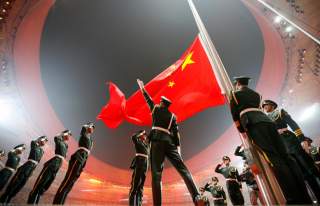America Must Have a Grander Strategy for China
The mere fact that American strategists are debating and considering a new grand strategy leads one to believe that those past American policies now have failed to assuage concerns vis-à-vis a rising China.
Finally, Envelopment can be replicated and incorporated by America's allies, partners, and other like-minded nations. In this way, Envelopment is a force multiplier. A generation ago Containment was applied by America and its allies around the world in hot spots from South America to Africa to Southeast Asia with varying degrees of success. But Envelopment should not be likened to Containment. Containment, the foreign policy based on George Kennan’s “Long Telegram Home” State Department cable and his 1947 “The Sources of Soviet Conduct" article in Foreign Affairs, guided American strategy for more than forty years. It sought to stifle the expansion of communism by sequestering it. Envelopment could be leveraged in this way, but it is more adaptable than that.
Taking into account the three tenets, Envelopment could best be visualized as a strategic amoeba that can move dynamically. At one moment it may appear to be shrinking, only to expand the next and in a different area. It is not a one-size-fits-all strategy, rather it is malleable and can be scaled based on conditions across the globe. Envelopment could be configured to ‘contain’ an adversary akin to Containment noted above. There may well be instances where a sequester-like methodology may be advantageous to deploy. In other situations, concepts from other proposals and even those from “Competitive Co-existence” may be germane such as accepting risk and friction to recalibrate PRC actions threatening American interests or holding steady in contested areas to thwart PRC dominance.
Another important aspect of Envelopment is that it is not based on a zero-sum game. By tossing out the zero-sum game playbook, flexibility is placed in the strategist’s hands for action across the expanding landscape of power and influence in growing domains such as information with the scripting of powerful strategic communications via social media or in space by deploying new distributed satellite constellations. What could be perceived as a “loss” in one instance may set up the conditions for a ‘win’ in the future? As opportunities open and close across domains and players, an apt adage to describe Envelopment would be this: keep your friends close, those that are not, closer.
Yet, what makes Envelopment unique is its empowerment of the individual envelopment practitioner or enveloper at the ground-level. An enveloper appreciates the current strategic complexity and acknowledges that issues and challenges can span multiple areas and fora of national and international power and influence. As such, it is critical to note that solutions will require an inter-woven or what academics refer to as a “cross-disciplinary” approach in implementing a response based on the above three tenets. For example, an enveloper could employ a small economic tariff or informational counter-campaign as one of many tools in the tool-box of national influence in retaliation to a diplomatic grievance.
Envelopment Is Not Necessarily Bellicose
For those assessing Envelopment through a military and national security lens, Envelopment is the ultimate deterrence posture. This is because it offers policymakers pragmatic and flexible options with an air of measured unpredictability. But this strategy is not and should not be premised solely on a martial response. If circumstances dictate, the strategy can escalate up to a martial interpretation of “envelop,” which means “to mount an attack.” Taken to a policy extreme, Containment failed to ‘contain’ Vietnam. In the last two decades, vague and changing American commitments premised on the Bush Doctrine lead to “infinity wars” in the Middle East and Afghanistan. These examples of strategic policy gone awry have drained American blood, treasure, and prestige. Envelopment should not be construed or contorted to these ends as a primary or only strategic response.
Envelopment with ‘Chinese Characteristics?’
An authoritarian form of Envelopment appears to have already been rolled out by China. Ground truth purports a strategy that supports authoritarian values, applies a whole-of-society approach and leverages all facets of national influence, and can be incorporated by others. Programs like the Belt and Road Initiative and “Made in China 2025” provide guidance, know-how, services, and goods at the strategic level. Concepts such as dual-use and civil-military fusion propel span PRC entities from state-owned enterprises to scientific research. Meanwhile, Chinese commercial entities with deep ties to the PRC leadership apparatus like Huawei prop-up autocratic regimes with spyware and large surveillance systems as seen in Uganda and Zimbabwe. But these efforts should not be construed as Envelopment. Envelopment prioritizes its values first.
Conclusion
But as Sen. Ben Sasse (R-Neb.) notes, “a Chinese-led future is not inevitable. . . The challenge that China presents is not simply political, or economic, or military—it is, at the extreme, civilizational. China is advancing a new model of rule, a new model of how human beings can and ought to live together. That model is not only different from ours; it could be fatal to it.” As Sasse acknowledged, America does not have a coherent PRC strategy. Moreover, America needs a grand strategy for more than just the PRC. Now there is one: Envelopment. It is a coherent grand strategy for China, one that can be applied to other national security challenges to ensure America retains its global leadership.
Wilson VornDick is a China, national security, and emerging technologies expert at RANE and Duco.
Image: Reuters

